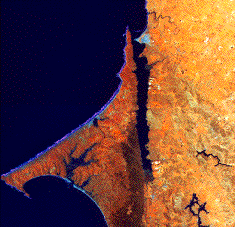
NASA ER-2 false color infrared photograph of Tomales Bay, California, and surrounding watershed. For scale, the bay is approximately 20 km in length and is oriented NW-SE. (NASA photo).
Click on the small pictures to see them at a larger size.
NASA ER-2 false color infrared photograph of Tomales Bay, California, and surrounding watershed.
For scale, the bay is approximately 20 km in length and is oriented NW-SE. (NASA photo).
Click on the small pictures to see them at a larger size.
There is a growing concern about human perturbation of the global environment. Nowhere is this effect more severe than in the coastal zone. The coastal ocean occupies only a small area of the globe, but this region is the most used and abused region on earth. Approximately half the world's population lives within 100 kilometers of the sea coast. The region is used for sheltering, feeding, transporting, entertaining, and otherwise supporting most of the world's population. Activities on land even far removed from the ocean result in massive transport of materials to the ocean via runoff, ground-water, and atmospheric transport. The ocean, and particularly the coastal ocean, is the global sewer.
In recognition of the complex environmental problems within the coastal zone, both national and international agencies are stepping up research directed at this region. For example, in 1988 the U.S. National Science Foundation began a research initiative called Land Margin Ecosystems Research (LMER) directly designed to investigate the biogeochemical coupling between land and the coastal ocean, and the human perturbations of that coupling. A related effort internationally, the International Geosphere-Biosphere Programme (IGBP) Core Project Element called LOICZ (Land Ocean Interactions in the Coastal Zone) began in 1995.
Tomales Bay was chosen as an LMER study site in 1989 because its simple geometry, small surrounding watershed, and readily defined characteristics of freshwater flow and internal water circulation make the site especially tractable for the analysis of how a whole system receives, processes, and exports materials. In this system freshwater (hydrological) transport dominates material inputs, and the hydrological cycle shows several characteristic time scales of variation. This program was named "BRIE." The name is, at once, an acronym for "Biogeochemical Reactions in Estuaries" and acknowledgment that dairy farming is a traditional livelihood for the region.

This page was last updated by SVS Sunday, 19 January 1997.
Maintained by Stephen V. Smith at svsmith@soest.hawaii.edu